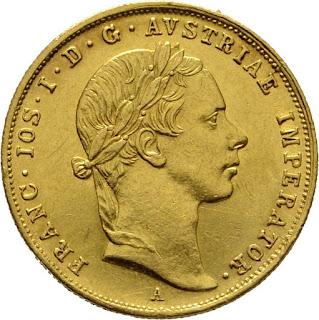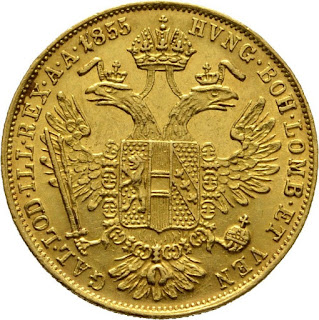Austrian Gold Coins 1 Ducat 1855 Emperor Franz Joseph I
Obverse: Laureate head of Emperor Franz Joseph I, ruler of the Habsberg Empire right. Surrounding his portrait is the Latin inscription “FRANC ∙ IOS ∙ I ∙ D ∙ G ∙ AVSTRIAE IMPERATOR ∙” translating as "Franz Joseph I by the Grace of God Emperor of Austria".
Reverse: Crowned Imperial double eagle - Imperial Coat of Arms of the Empire of Austria, used from 1815 to 1866, framed with the inscription “GAL ∙ LOD ∙ ILL ∙ REX ∙ A ∙ A ∙ 1855 HVNG ∙ BOH ∙ LOMB ∙ ET VEN ∙” (King of Galicia, Lodomeria, Illyria, Hungary, Lombardy and Venice).
Composition: Gold.
Fineness: 0.986.
Weight: 3.4909 g.
AGW: 0.1107 oz.
Emperor Franz Joseph I
Franz Joseph, also called Francis Joseph (born August 18, 1830, Schloss Schönbrunn, near Vienna, Austria — died November 21, 1916, Schloss Schönbrunn), emperor of Austria (1848–1916) and king of Hungary (1867–1916), who divided his empire into the Dual Monarchy, in which Austria and Hungary coexisted as equal partners. In 1879 he formed an alliance with Prussian-led Germany, and in 1914 his ultimatum to Serbia led Austria and Germany into World War I.
Austrian Ducat Gold Coin
The word ducat is from Medieval Latin ducatus meaning “relating to a duke (or dukedom)”, and initially meant “duke’s coin” or a “duchy’s coin”. These historical gold coins were used in trade throughout Europe from medieval times to the late 20th century.
The first gold ducats were produced in the year 1140 and the inscriptions and pictures changed considerably through the Middle Ages. One of the most common versions seen today is the Austrian 1 Ducat Gold Coin.
The front of the Austrian 1 Ducat Gold Coin which features the likeness of Franz Joseph I who was born in 1848, and died in 1916. The reverse depicts the House of Habsburg’s coat of arms. The Habsburgs occupied the Holy Roman Empire throne from 1438 – 1740. They produced kings of Bohemia, England, Germany, Hungary, Croatia, Ireland, Portugal, Spain Dutch and Italian countries.
The double-headed eagle or Imperial Eagle was a symbol of the Holy Roman Empire. Above the Imperial Eagle is the Imperial Crown worn by Holy Roman Emperors from the House of Habsburg becoming the crown of Austria after the dissolution of the Holy Roman Empire. The Imperial Eagle holds the Imperial Regalia or the crown jewels. The Imperial Eagle holds the Imperial Sword, which was used during coronations and holds the Imperial Orb, a symbol of divine right.
Today’s modern Austrian 1 Ducat Gold Coin follows in the steps of the Austrian 100 Corona because those dated 1915 are re-struck. A re-strike is an official reissuing of a coin which is no longer in production. The Austrian 1 Ducat is made of gold which is 0.987 pure (high purity) and its melt weight in gold is 0.1122 troy.
So this virtually pure gold coin contains a little over 1/10 of an ounce of pure gold. It is about 0.777 or slightly more than ¾ of an inch in diameter so it makes a statement. To attain this size/purity ratio the Mint makes the Austrian 1 Ducat Gold Coin thin (about 0.0314 inches) and in so doing produces one of the great pure bullion products today.
These beauties are large for their weight and the coin’s purity is instantly recognizable as real gold. The Austrian 1 Ducat Gold Coin offers other advantages:
1 - it is minted by a sovereign government so production, purity and weight are guaranteed allowing precious metal dealers worldwide to post daily buy and sell prices.
2 - The Austrian 1 Ducat Gold Coin enjoys a worldwide audience because premiums are low and it is a recognizable bullion coin having been traded for decades. Its smaller size also makes this pure coin a excellent barter choice.
3 - The re-strike Austrian 1 Ducat Gold Coin also offers a possible government foil. Because of its date (1915) this coin was a popular way of getting around the US prohibition on gold ownership prior to 1975 in the United States. For this reason some believe that if gold were confiscated in America the Austrian 1 Ducat Gold Coin might be exempt because of its dating. Whether you buy the argument or not it is nonetheless a reason for this coin’s continued popularity.
4 - There is no reporting requirement (Federal Form 1099B) when buying or selling the Austrian 1 Ducat Gold Coin and it fluctuates directly with the daily gold market.

